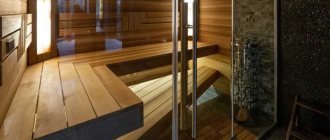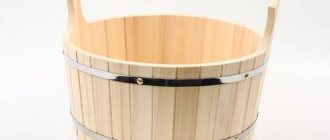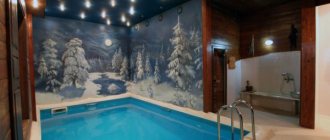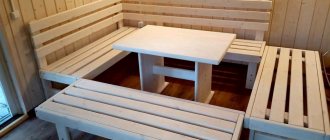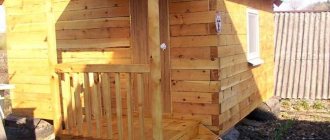The bathhouse is a special type of room. This is due to the fact that it contains high humidity and constant exposure to different temperatures. That is why lighting in a bathhouse needs additional protection and special installation.
Amateur photo of using several lighting fixtures in the steam room section
>
Why is there low voltage in the bathhouse?
In most rooms in the bathhouse, ordinary household voltage ~220 V is used, but in the shower room, steam room and other rooms with high humidity this is allowed subject to additional safety measures:
- Installation of RCDs or automatic circuit breakers. These devices disconnect electrical appliances and wires when insulation is broken or people touch live parts.
- The room must have a TN-CS grounding system. In this case, the distribution of the neutral wire “N” and the grounding conductor “PE” throughout the building is carried out with separate wires, which are connected in the water panel.
- Availability of a potential equation system for the SUP. This is the connection of ALL metal parts of the structure - water and sewer pipes, lamp housings, window bars and other elements to each other and to grounding.
It is difficult to meet these requirements at home, so it is more advisable to lower the voltage to 36 or 12 volts. It is preferable to use 12V, as it is safer.
Reference! According to PUE 7.1.47, the use of electrical appliances with voltages higher than 12V inside a bathtub or shower tray is prohibited.
PUE standards
PUE is “Rules for the construction of electrical installations”. A rather extensive Talmud, in which you can find individual statements relating to the bathhouse, or more precisely, to a room with a high fire hazard, humidity and temperature.
IMPORTANT! Information about the bathhouse in the PUE is scattered; you will not find there a separate chapter about bathhouses, saunas, and washrooms. We have collected all available information for you, the rest applies to general cases.
Let's start with the electrical panel. Of course, you will not allocate a separate room for it; most likely it will be a small closet , but you should take into account that in the bathhouse it must be reliably waterproofed. Here's what the PUE says about it:
We’ll talk about the contents of the cabinet a little lower, but here’s what the rules say about the need for an RCD :
Along the way, we note another point that concerns the minimum degree of protection class of such a cabinet if it is located in a fire hazardous area:
Wiring runs from the panel to all rooms. How to carry it out correctly - inside the walls or on the surface? The standards say that hidden is preferable, but this applies only to hot and humid rooms - a sauna (this means a sauna steam room), a bathtub and a shower. In other rooms of the bathhouse, you can follow the recommendation about the preference for open wiring in a wooden structure.
As you can see, if it is possible to lay wires inside bath walls, then only in plastic sleeves, and the plastic must be non-flammable, that is, not support combustion (you can’t expect anything more from corrugation).
In the event that you have to connect or extend wires, the PUE recommends the following:
Now about wet rooms. Neither switches nor other distribution or control means should be located inside the steam room or washing room:
ADVICE! This suggests the idea that it is necessary to plan the placement of electrics for a bathhouse at the drawing stage - only in this case you will not have to rack your brains about how to conduct wiring in a building that is not conducive to compliance with standards.
As for the degree of protection of the installed equipment, for these premises it must comply with the following paragraph of the PUE:
Sockets inside the washing room and steam room are prohibited by the following clause:
Requirements for lamps in fire hazardous areas and the minimum degree of their protection in the following paragraphs of the PUE:
Finally, let us mention the point regarding potential equalization:
Steam room feature
A steam room in a bathhouse is at the same time the hottest and most humid room. Both have a significant impact on wiring requirements.
IMPORTANT! The most important prohibition is that there should be no wiring inside the walls or along their surface in the steam room. It is all done outside this room, and only connectors for connecting lighting are inserted inside.
Yes, inside the steam room of a regular bath there are only electrical appliances for lighting. And the switches for the lamps are outside.
Metal sleeves are used to pass wires through the wall . This is the only acceptable case of using metal tubes inside walls.
As you saw above, you cannot make any sockets inside the steam room. Power plants such as electric furnaces are discussed in the next chapter.
Features of a sauna with an electric stove
The electrics in a bathhouse with an electric furnace are supplemented by a group of wires that are intended for power plants . In principle, you can have a brick or iron wood-burning stove, but if you put a washing machine in the bathhouse, you will still have to create a power group all devices except lighting .
ATTENTION! Since the stove power should be calculated at the rate of 1-1.5 kW per cubic meter of space, we get quite a decent load even for a conventional steam room of 2x2x2 meters - 8-12 kW.
Typically, electric ovens are already equipped with power cords with sufficient protection from high temperatures. Therefore, it is enough to simply take the power cord outside the steam room and connect it to an outlet (with grounding!) in the adjacent room.
In addition, it is recommended to create a separate grounding loop for the entire steam room in which the electric stove is installed. This is done at the construction stage, during work with floor waterproofing . A steel mesh should be laid over the waterproofing, and a steel strip should be laid around the perimeter. Later, the strip is welded to the mesh and the electrical panel is brought to zero.
ADVICE! If you install a 30 mA difavtomat in the panel, you can connect the stove to the network directly. Otherwise, you will need a device that will monitor the steam room for overheating or a short circuit.
Benefits of reduced voltage
Low voltage in baths and saunas has advantages:
- 12 volts is safe for health and life;
- electrical wiring in low voltage networks can be laid openly without the use of a corrugated pipe or cable duct at any height;
- short circuit current is limited by the supply electrical transformer, which reduces the risk of fire;
- installation and maintenance can be carried out by personnel who do not have the appropriate electrical safety clearance group.
Types of step-down transformers
To supply reduced voltage to the electrical network of the bathhouse and sauna, a step-down transformer for the bathhouse 220 to 12 V is used. These devices are of different types.
Electromagnetic
The windings in these devices are wound on a magnetic core made of transformer iron. They have lower efficiency, larger dimensions and lack of built-in protection against overload and short circuit.
The advantage is that it is easy to find a transformer of suitable power in old radio equipment and rewind the secondary winding yourself.
Important! LED strips cannot be connected to electromagnetic transformers, even through a diode bridge, due to light pulsations with a frequency of 100 Hz. It's subtle, but harmful to the eyes.
Electronic (pulse)
More modern devices, smaller dimensions and higher efficiency. Some models have internal overload protection.
Why you can't use autotransformers
An autotransformer cannot be used to power electrical appliances in a bathhouse. In these devices, the secondary winding is connected to the primary and is energized.
Therefore, lamps connected from an autotransformer are also connected to a 220V network, which limits their use in showers, steam rooms and other rooms with high humidity.
Useful video
We do not agree with everything that the author of this video says, for example, when he recommends metal corrugation, which is prohibited by the PUE. But regarding the use of RKGM for inserting wires into steam room lamps, we completely agree.
*** So, this article examines only part of the theoretical issues related to electrics in the bathhouse. The practical part, which describes the procedures for installing it yourself in specific rooms, will be in the next article.
The topic of wiring in a bathhouse is discussed more widely on the page of the corresponding section.
E-mail
Article in sections: Wiring in the bathhouse
Selecting a step-down transformer
The choice of electric transformer model is made according to several parameters.
Input voltage
In everyday life, a voltage of 220 volts is used, which must correspond to the parameters of the primary winding. To reduce the current and wire cross-section, models used in production are manufactured with a primary winding rated at 380V.
Output voltage
Should be 12V. If there are several terminals and no markings, a test switch is performed and the parameters of the coils are checked with a voltmeter.
Power
It is selected based on the total power of all lamps connected to the transformer with a margin of 20%.
For example, for 3 lamps with a power of 60 W, a power supply device with a power of at least P = 60 * 3 * 1.2 = 216 W is required.
Degree of environmental protection
There is an opinion that all electrical appliances, including electrical transformers, used in a bathhouse, must have a moisture protection rating of at least IP67. However, this only applies to equipment installed in wet areas.
Equipment items
The time has come to consider each of the elements of the above diagrams in more detail.
Cable
Let's start with the important thing - you need to choose the cable for a bath correctly, taking into account everything - wooden surroundings, high temperatures, fire hazard, high humidity.
Ideal option: you do not run the cable at all either along the walls or inside the walls of two rooms - the steam room and the washing room . Instead, make through holes in the walls where the lighting point will be, and lead only the ends of the wires directly to the lamp into the steam room and washing room.
ADVICE! The through hole should be reinforced with a metal (aluminum) sleeve. If a shift occurs in the structure, the sleeve will protect the cable from damage.
If you don’t have any wires laid in the steam room and soap room, then you don’t have to worry about heat resistance - the temperature range (up to +60 degrees) that is typical for good, suitable wires for wiring in other rooms is sufficient. This is the NYM cable made according to the German standard and its Russian analogue VVGng.
IMPORTANT! Both have a PVC shell, although it has additives that do not support combustion.
There is heat-resistant insulation that can withstand elevated temperatures and is made of silicone rubber . It is used in PRKS and RKGM cables. The latter is often installed in damp and/or high-temperature rooms - bathrooms, bathhouses, basements. Be guided by the above - such a wire is needed where it is not possible to avoid wiring inside the steam room and washing room.
ATTENTION! The requirement for the (not recommended) wire in the steam room is that it must withstand a temperature of (minimum) 170 degrees.
Cable fastening
As we mentioned above, hidden and open wiring is allowed in the bathhouse. If the choice is made in favor of a hidden one, then it should be hidden exclusively in a plastic corrugation, and not a metal one.
If the wiring is open, then you can use standard cable channels , choosing those that best match the color and texture of the walls, and twisted wiring through ceramic insulators.
Cable channel, pine color
ON A NOTE! However, it is worth drawing your attention again to the fact that all this is said about laying wires in the dressing room, rest room and other (if any) rooms, but does not apply to the steam room and soap room.
Cable channels are not heat resistant ; they are ordinary plastic, flammable and easily melting. Therefore, you can often find a recommendation to place strips of heat-insulating material under open wiring.
How to calculate the required cable power?
To do this, you need to know the power of all expected current consumers - the lighting group and all connected electrical appliances. Count the number of lamps and add up their power . Look in the passport of the stove, washing machine and everything else that you are going to connect, their rated power . Add everything up into one total. Add to it 1/5 of the resulting figure - this is reserve .
The resulting figure must be divided by the network voltage. It can be 220, 380, 12, 24, 36 volts. If you combine them, divide the power of the group by the corresponding voltage. The result of division is the strength of the current flowing through the conductor . is this that determines the suitable cross-section of the core.
The table below shows the relationship between the mentioned quantities:
Transformer
A transformer for a bathhouse is only needed if you decide to provide lighting in the steam room using low-voltage light sources: halogens, low-voltage incandescent lamps, LED strips . The latter, of course, react poorly to elevated temperatures, but the widespread practice of installing this type of lighting in the lower tier of the steam room, usually under the seats.
Accordingly, a transformer is selected that transfers from the input (220 or 380 volts) to the required (12 - most often, 24, 36 volts).
Transformers differ in power , which is as easy to calculate as in the previous example - it is desirable that the power of the transformer itself be 1/5 greater than the total power of the lamps that you intend to connect to it.
In principle, you can purchase the same LED strips with a power supply , which itself will lower the voltage to the required number of volts. If you still decide to install a transformer, then you can install it in a panel , on a certain group of consumers - light sources in the steam room.
IMPORTANT! When powering LEDs, current is a more important characteristic than voltage. It is advisable to further protect their network surges by installing a stabilizer.
Lamps
You can put any kind of lamps in the bathhouse. The debate is mainly about the steam room and the washing room - is there any reason to install low-voltage lamps if you already have an RCD or automatic circuit breaker. But, if you think that God protects those who are careful, then, most likely, you will put the already mentioned halogens or LEDs there.
If you decide to install LEDs, you should measure the temperature in the heated steam room. Where it is planned to run the tape, it should not rise above 40 degrees! More information about this type of lamp can be found in the article entirely devoted to LED lighting.
Halogen lamps can be installed where the temperature is not higher than 100 degrees , although other characteristics of these lamps are inferior to LEDs.
Incandescent lamps - if the lamp is installed in a lamp that is attached to the wall, then the power should not exceed 60 W. We found no temperature restrictions.
Lamps
Again, the distinction: if the lamp is in the rest room, then it can be anything, even a crystal chandelier - here the choice is limited only by the taste of the owner. You can also put whatever you want in the waiting room. But when it comes to washing, the main requirement will be moisture protection. Therefore, the minimum moisture protection requirements are IP44, but it is better that the last figure is higher - for example, IP65. You can read more about bath lamps here.
The same can be said about the steam room. In both cases, we are talking about hermetically sealed structures, in which the base is made of ceramics and the shade is made of glass . We have materials dedicated separately to lamps in the sauna and in the steam room of the Russian bath.
Sauna, lighting under the shelf
IMPORTANT! The fact that it will be made of glass and not plastic is significant. Because plastic melts. As for the possible breaking of glass, the installation of a decorative wooden fence, which will at the same time be an element of the decor of the steam room, will protect against this.
There is supposed to be a gasket between the lampshade and the base. Rubber ones fail relatively quickly. Check back occasionally, because otherwise the lamp will lose its seal.
By the way, you can read about lampshades for bath lamps here.
Sockets
The requirements for moisture protection (I P-44 / IP-65 ) mentioned in relation to luminaires also apply to sockets.
You can install sockets in any of the rooms, except for the steam room and soap room.
Making a transformer for a bathhouse with your own hands
If you have an electrical transformer of appropriate power, it can be converted into a transformer for a 220 to 12 volt bath.
To do this, you need to rewind the secondary winding:
- measure the voltage Uout at the terminals of the device;
- disassemble the magnetic circuit;
- remove the coil;
- unwind the primary winding, counting the turns Nstar;
- calculate the required number of turns using the formula Nnew=Ncstar/Uout*12V;
- calculate the current in the secondary winding using the formula I=Ptr/12;
- Using special tables or using an online calculator, determine the required cross-section of the winding wire;
- wind the secondary winding;
- secure the wire and wrap the coil with keeper tape or glass tape;
- assemble a magnetic circuit;
- check the electrical transformer in operation.
In some tube receivers, the transformers have 2 6.3V windings. Series connection of these coils gives 12.6V, but the cross-section of the wires of these windings does not allow the use of this 12V transformer for a bath.
Switching lighting to a lower voltage increases the safety of people, but at the same time the current consumption of the lamps increases. Therefore, it is necessary to strengthen the power cables and circuit breakers.
Principle of organization
First of all, it should be noted that you need to start work only when the master has a plan for the placement of all devices in the room and a connection diagram. They are made in advance using the principles of creating electrical circuits and installation rules.
Special luminaire with protective cap and sealed inlet
Selection of materials
- Particular attention should be paid to all devices that will be placed in the steam room and shower.
- They must have a high degree of protection from moisture and resistance to high temperatures. Most of these products are made in a special sealed case, and if glass is used, they have high heat-resistant characteristics.
- If you do the bath lighting yourself, then you should immediately take care of protection for wires and cables. For these purposes, a special corrugation is used, which is made of fire-resistant plastic.
- It is worth noting that at the moment there are a lot of different fakes or low-quality products that do not correspond to the declared characteristics. Therefore, before making a purchase, you should ask the seller for a quality certificate.
Special step-down transformer that can be used for a bath
- It should be noted that some craftsmen, when lighting a bathhouse, try to use low voltage currents for the circuits. Then you will need a special step-down transformer, which should preferably be located in a separate protected housing or in the input panel.
- It should be noted that the box for routing wires and placing machines must also be highly sealed, but it is advisable to place it in the dressing room.
Advice! When purchasing all the necessary elements, you need to immediately check their integrity on the spot, and, if possible, even disassemble them to determine the integrity of all parts. Otherwise, you may buy products that were damaged during transportation.
Location of wiring in a timber structure using protective corrugation
Installation
- Typically, lighting for saunas and baths begins with wiring.
- They must be immediately placed in a protective corrugation and in those places where an exit or branch needs to be made, heat-resistant insulation should be used.
- To secure the wiring under the casing, you need to use a synthetic harness that can withstand high temperatures. Special clamps are also used.
Step-by-step process of installing a lamp in a steam room
- If lighting in the bathhouse is done after all the coverings have been installed, then professional craftsmen recommend installing protective boxes. They must also be sealed and are made of heat-resistant plastic. In this case, corrugation may not be used.
- All point-of-use devices with a similar level of protection have special inlet openings that allow for a high level of sealing. At the same time, the installation instructions advise you to accurately carry out all the fixing actions that a specific design provides.
Lighting arrangement diagram
- It is worth noting that it is recommended to place only a lamp in the steam room, and it is better to keep other systems and devices away from rooms with extreme temperatures and high humidity. This is especially important when installing a step-down transformer, since it is on it that eddy currents arise, which are transmitted using a magnetic circuit.
- Some masters try to connect each individual device through its own machine. However, this is very wasteful, since the price of such systems is quite high, considering that they are manufactured for such conditions. That is why it is much easier to transfer all the lighting to one circuit breaker, leaving a separate lamp as an emergency system on another fuse.
Residual current device and their parameters
- If you plan to use devices with high power in the building, then they should be connected to a separate circuit breaker, and best of all to a dedicated phase. This will protect the entire system from short circuits and in the event of an emergency shutdown of this line, the lighting will continue to operate in standard mode.
- Professional craftsmen advise that it is mandatory to install grounding in the bathhouse or to include an RCD in the circuit. This will serve as additional protection against electric shock, which is very important for rooms with high humidity.
Advice! It must be remembered that the system can be connected only after it has been completely installed and tested. This will avoid electric shock.
An example of a sauna electrical circuit
